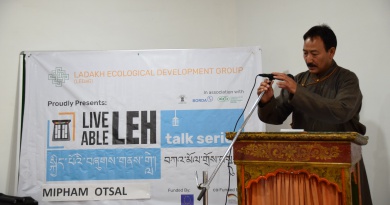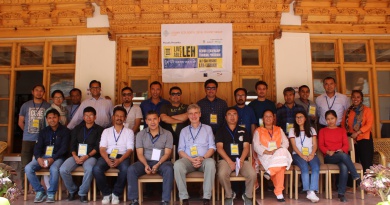Talk Series Heritage Walk
Activity: Talk Series: Heritage Walk Date: August 18, 2018 Location: Leh Old Town Participants: 18
Speaker: Tashi Morup, Project Director of Ladakh Arts and Media Orgisation (LAMO)
- Objective: To understand the art, architecture, structures and history of the Leh Old Town area
- Summary Agenda:
Time Activity PiC 2:00 PM Welcome Speech Tenzin Motup 2:10 PM Overview of Liveable Leh Project Dr Nordan Otzer 2:30 PM Heritage Walk Tashi Morup 4:30 PM Vote of thanks Tenzin Motup
- Summary of Results:
The water flour mill at Chhuti Ranthak was built with Balti technology in the 16th century and the entire area had a series of ranthak. The flour generated from the mill was supplied to the bakery market nearby.
Leh was an important trade centre and once could see ten different people from ten different countries in the Leh market. A gate was erected on the foothills of the Leh Palace to levy tax from traders coming from Khardung La side.
Central Asia had built the bakery market, whereas the Shia mosque in Chhuti Ranthak was built at the time of Mughal emperor Aurangzeb. The area near the mosque was modelled on Victoria Bazaar and was therefore erstwhile named Victoria Bazaar.
The Old Town area could be reached from six different gates, but due to pillaging now only four gates are remaining. The Stupa Gates were called Kagani and had rock carvings on it, which were carved by artists accompanying traders in the 7th century.
Leh City was fortified to prevent attack by the Dogra Army. Leh City was divided into two parts: Skyanas (beyond the wall), Gogsum (Three walls).
There are three monasteries of Maitreya Buddha (Future Buddha) in Old Town which were built at the time of King Tashi Namgyal in the late 15th century.
There were different buildings which belonged to officers in the King’s court. There was Onpo (Astrologer), Lhardak (caretaker of the Lhato of the Palace), Takshosma (dancers at the courtyard), Munshi (secretary).
Ladakh was earlier ruled by chieftains and it was during the reign of King Singge Namgyal who managed to unite the whole of Ladakh with the help of Lama Staktsang Raspa who was his teacher.

